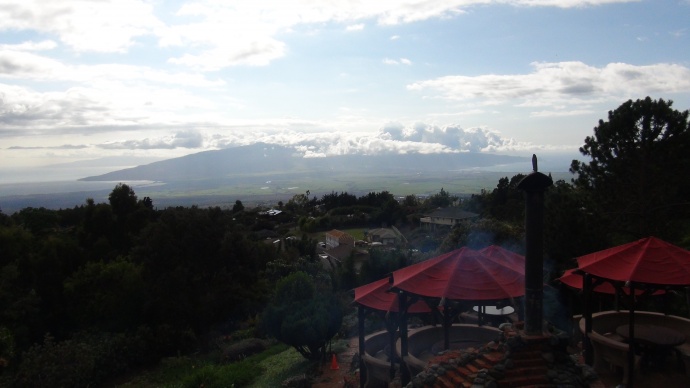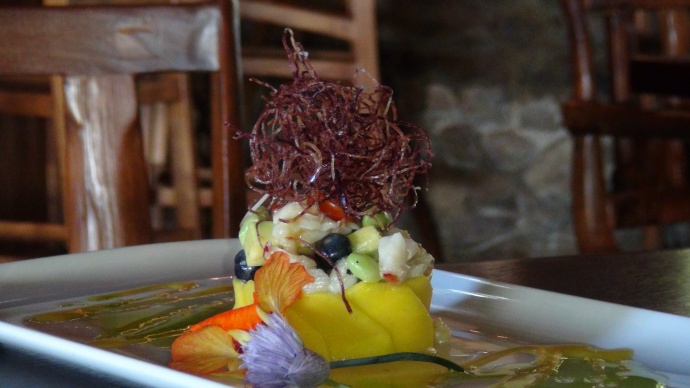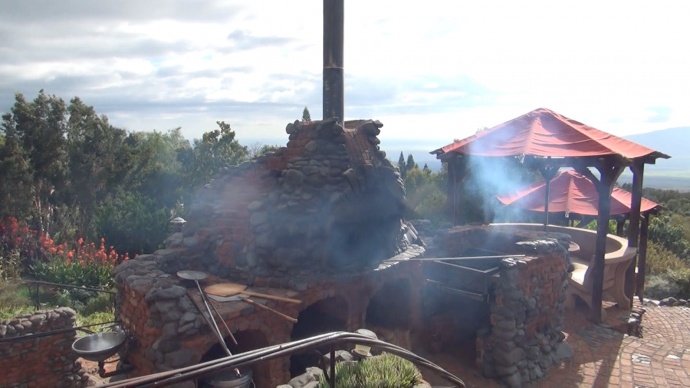A Fascinating Past, A Changing Future at Kula Lodge
[flashvideo file=http://www.youtube.com/watch?v=HVaRn1cvvYo /] By Kiaora Bohlool
It’s a crisp, clear night in Kula. Bright stars blanket the sky. Kula Lodge is the place to be. Frank James, who built the place in 1940, has started inviting friends and guests to enjoy his Lodge, which was originally his home. The year is 1951, before such things as liquor licenses. Instead, a cigar box sits out. Party goers discreetly slip cash into the box, then pour their own drinks…maybe a vodka Martini, a Gimlet, even a Mai Tai. Well-dressed men in suits and ladies in party dresses clink their glasses by the warmth of the stone fireplace, maybe singing along to Tony Bennett, Nat King Cole or Mario Lanza.
Okay, let’s clear the cigar-smoke-filled air and fast-forward almost 65 years. Kula Lodge is still standing; a rustic, majestic presence on the slopes of Haleakalā. After Frank James died, the property passed to his daughter and fell into bankruptcy in 1984, when Fred Romanchak (whose grandparents were the James family’s nearest neighbors) and his wife Susan bought it. As more neighbors have moved in around the scenic hillside, the music has modernized, the crowds have quieted, and the menu is in the midst of an impressive, and some would say necessary, transformation.
“The culture has to be changed,” says Executive Chef Marc McDowell, who’s been leading the charge in Kula Lodge’s kitchen since April. “So first, you go from things that might not have been homemade to a ‘scratch kitchen.’ Everything’s made from scratch, whether it’s the breads, the sauces, the stocks, the dressings, getting fine cuts of fresh fish daily, nice cuts of beef, natural chicken, hormone-free chicken; all the products you bring in have to be nice, ‘cause it’s good in-good out.”
McDowell has spent almost 25 years cooking in some of Maui’s finest resorts, including the Grand Wailea, Ritz Carlton in Kapalua, and Mākena Beach Resort (formerly the Maui Prince Hotel), where he served as Executive Chef. He was drawn to the rich agricultural treasures of Kula, which he calls Maui’s Bread Basket, and harnesses that farm-to-table vibe at every turn.
“It’s all about sustainability,” he explains. “I believe that if you’re buying everything from the mainland, you’re not supporting your local farmer, or the ranchers, or anybody. If you’re supporting your local economy, you’re doing your part that really needs to be done, and it’s gonna be fresher, it’s gonna taste better, it’s not gonna travel a long distance. It’s really the only way to go for me.”
McDowell can also find many of his favorite, fresh ingredients just steps from the kitchen. In the picturesque gardens planted around Kula Lodge, traditional and exotic herbs abound, almost like a tasty world tour: Mexican stick oregano, Greek oregano, Portuguese oregano, French tarragon, Mexican tarragon, apple mint, pineapple mint, and gigantic bushes of rosemary.
“Freshness. They’re going to experience the senses,” says McDowell. “Number one, it has to be visually stunning when they get a dish, ‘cause first they’re going to eat it with their eyes. But then when they start to taste it, it has to be, if not even more than the visual, it has to complete the task at hand, which is, when they get the bill at the end, if they’re thinking about the bill, or contemplating, ‘Was it too much or not?’, then I didn’t do my job. I want it to be, it didn’t even matter what the price was: that was an experience.”
McDowell just rolled out a new menu in mid-July, which includes some sophisticated offerings, like a duet of Ahi and Hamachi served inside of a very cool ice dome, an Aleppo pepper and coffee-crusted ribeye, and poached lobster paired with a six-ounce cut of filet mignon.
The chef also put a fresh spin on the lobster pinwheel, which he used to make with heirloom tomatoes…but couldn’t resist the luscious mangoes upcountry. “It’s fresh Kula mango, it’s hearts of palm that come from Hamakua Farms,” he says. “It’s blueberries, it’s edamame, it’s beautiful butter avocados, and it’s all wrapped in a mango pinwheel. Lobster, blueberry and vanilla love each other, so I just married that one.”
Along with epic island views, the garden terrace below the restaurant has a kiawe-fired artisan pizza oven, which is working overtime. Chefs have been making dough fresh every day.
“They start at 8 in the morning; at 11 a.m. we start selling our pizzas, and all the way until about 8:30 at night we’ll sell the pizzas. We do a great business. It’s not easy, but then again, things that are artisan, that have the love involved, they’re worth it.”
So the pizzas are selling like hotcakes. And the hotcakes are selling like…hotcakes. Meaning, breakfast is as busy as it’s ever been, thanks to all those hungry sunrise-seekers and bike riders coming down the crater. Just ask Director of Operations Bryan Ashlock, who says between 7 and 9:30 a.m. and often beyond, the place is buzzing like a swarm of bees.
“It goes right from breakfast into lunch; those culinarians back there, they are machines! I’m impressed by the energy that they have,” says Ashlock, a culinary veteran of Sheraton fame, who recently got right in the mix of a very kinetic Kula Lodge kitchen. “I was working the line myself just to show them I can do it, and man, I got home that night and I said to myself, my feet were sore — try standing on your feet for 12 hours!”
Ashlock and McDowell both agree, dinner is where the dining room needs a boost.
“We haven’t even tapped into that well, and that is where the goldmine could lie,” explains Ashlock. “There’s a lot of hidden treasures here, and breakfast and lunch are very successful. Dinners are very soft.”
The Lodge is dialed in with the daily visitor crowd, but leaders want to entice more locals up to Kula. As one idea, they’re considering plans to offer some special “tapas,” or small platters of food, in the Garden Terrace around sunset a few nights a week.
McDowell says to handle a full house for dinner, staff members need to be on-board, and in-sync. “There are lots of plans that we want to have for here, but it just has to be step-by-step and make sure the staff is going along with that direction, and you don’t jump ahead of them where they can’t catch up, or the inconsistencies will come back.”
When it comes to staff, both men use the term “culinarian.” So…what exactly does that mean? “I speak of a culinarian as somebody who goes home at night and they wake up in the middle of the night, and they want to figure out how to get that sauce right, and it bugs ’em because it didn’t come out perfect,” explains McDowell. “A cook’s just gonna go, do their job, go home and enjoy their life, and not even really think about food. A culinarian can’t get it out of their mind. I’m looking for culinarians here. That’s the kind of people who are going to create experiences for the guests that are here.”
Guests may get to experience a new kind of Kula Lodge as the future unfolds. Owner Fred Romanchak apparently has a vision, complete with site sketches on the lodge’s website to expand the dining area, turn the lodging into luxury suites, revamp the commercial area currently known as the Kula Marketplace, and create a health and wellness center. Initial drawings show a spa facility, outdoor pool, juice bar and more. The redevelopment plans have been going through the permitting and approval process for several years, but there could soon be some significant steps forward, thanks to this news:
“He has gotten the permits to renovate. He went through some loops and went though some hurdles on that,” says Ashlock. Romanchak was not available for direct comment on project details. “I don’t know when he plans to expand but he does have the permits to expand on the renovations.”
So, even though the Gimlet is no longer a top cocktail and Mario Lanza may not be booming from the record player, there’s one thing that has thankfully not changed at Kula Lodge: the fantastic, sweeping views of Maui from your table. And here’s hoping the food brought to that table is just as memorable.
“They’re magnetized by the view, and it is if you sit out there, and you just look at it, everybody compliments the view,” says Ashlock. “So what we’re trying to make sure is that that view is equal to the quality of the food. Both are heavenly.”


















